Apple Qmaster User Manual

Apple Qmaster
Distributed Processing Setup Guide
Copyright © 2009 Apple Inc. All rights reserved.
Your rights to the software are governed by the accompanying software license agreement. The owner or authorized user of a valid copy of Final Cut Studio or Logic Studio software may reproduce this publication for the purpose of learning to use such software. No part of this publication may be reproduced or transmitted for commercial purposes, such as selling copies of this publication or for providing paid for support services.
The Apple logo is a trademark of Apple Inc., registered in the U.S. and other countries. Use of the “keyboard” Apple logo (Shift-Option-K) for commercial purposes without the prior written consent of Apple may constitute trademark infringement and unfair competition in violation of federal and state laws.
Everyefforthasbeenmadetoensurethattheinformation in this manual is accurate. Apple is not responsible for printing or clerical errors.
Note: Because Apple frequently releases new versions and updates to its system software, applications, and Internetsites,imagesshowninthismanualmaybeslightly different from what you see on your screen.
Apple
1 Infinite Loop Cupertino, CA 95014 408-996-1010 www.apple.com
Apple, the Apple logo, Bonjour, Final Cut, Final Cut Pro, FinalCutStudio, FireWire, Logic, LogicStudio, Mac, MacOS, QuickTime, Shake, Xsan, and Xserve are trademarks of Apple Inc., registered in the U.S. and other countries.
AppleRemoteDesktop, Finder, and NetInfo are trademarks
of Apple Inc.
AppleCare is a service mark of AppleInc., registered in the U.S. and other countries.
Adobe, the Adobe logo, Acrobat, the Acrobat logo, Distiller, PostScript, and the PostScript logo are trademarks or registered trademarks of Adobe Systems Incorporated in the U.S. and/or other countries.
“Dolby,” “Pro Logic,” and the double-D symbol are trademarks of Dolby Laboratories. Confidential Unpublished Works, © 1992–1997 Dolby Laboratories, Inc. All rights reserved.
UNIX is a registered trademark of The Open Group.
Other company and product names mentioned herein are trademarks of their respective companies. Mention of third-party products is for informational purposes only and constitutes neither an endorsement nor a recommendation. Apple assumes no responsibility with regard to the performance or use of these products.
Production stills from the film “Koffee House Mayhem” provided courtesy of Jean-Paul Bonjour. “Koffee House Mayhem” © 2004 Jean-Paul Bonjour. All rights reserved. http://www.jeanpaulbonjour.com

Contents
Preface |
5 |
Welcome to Distributed Processing |
|
5 |
About the Apple Qmaster Distributed Processing System |
|
6 |
About the Distributed Processing Documentation |
|
6 |
Additional Resources |
Chapter 1 |
9 |
Distributed Processing Basics |
|
9 |
Using Distributed Processing to Increase Speed and Efficiency |
|
10 |
Basic Components of the Apple Qmaster Distributed Processing System |
|
13 |
QuickClusters |
|
13 |
Compressor AutoClusters |
|
13 |
How the Apple Qmaster System Distributes Batches |
Chapter 2 |
15 |
Getting Started Quickly |
|
15 |
Quick and Easy Distributed Processing |
|
19 |
About the Compressor Service Sharing Pane |
Chapter 3 |
21 |
Preparing a Network for Distributed Processing |
|
21 |
The Minimum You Need to Know |
|
22 |
Example of a Minimal Distributed Processing Network |
|
23 |
Using Compressor AutoClusters |
|
24 |
Other Possible Components of a Distributed Processing Network |
|
26 |
Example of an Expanded Distributed Processing Network |
|
26 |
Sample Setup for Part-Time Processing on Desktop Computers |
|
27 |
Configuring Access for Part-Time Distributed Processing |
|
29 |
Setting Up for Part-Time Distributed Processing with Shake |
|
30 |
Additional Steps for Distributed Processing with Shake |
Chapter 4 |
33 |
The Interfaces |
|
33 |
The Interfaces in the Apple Qmaster Distributed Processing System |
|
35 |
Apple Qmaster Pane of System Preferences |
|
41 |
Apple Qadministrator |
|
43 |
Compressor and Apple Qmaster as Client Interfaces |
|
45 |
Batch Monitor |
3

Chapter 5 |
47 |
Creating Clusters |
|
47 |
An Overview of Configuring a Cluster |
|
48 |
Configuring Service Nodes and Cluster Controllers |
|
55 |
Creating Clusters with Apple Qadministrator |
|
58 |
About QuickClusters |
Chapter 6 |
61 |
Administering Clusters |
|
61 |
Modifying and Deleting Clusters with Apple Qadministrator |
|
63 |
Monitoring Cluster Activity |
|
63 |
Accessing Activity Logs |
|
63 |
Setting Preferences |
|
67 |
Setting Passwords |
|
68 |
Scheduling Service Availability |
|
70 |
Using Cluster Storage |
|
73 |
Defining Ports for Service Advertisements |
|
73 |
Recovery and Failure Notification Features |
Chapter 7 |
77 |
Using the Command Line |
|
77 |
Installing Apple Qmaster from the Command Line |
|
78 |
Using the Command Line for Distributed Processing |
|
85 |
Using Scripts to Run Apple Qmaster, Compressor, and Batch Monitor |
Appendix |
87 |
Solving Problems |
|
87 |
Resources for Solving Problems |
|
87 |
Solutions to Common Problems |
|
92 |
Contacting AppleCare Support |
4 |
Contents |

WelcometoDistributedProcessing
 Preface
Preface
Transcoding or processing a series of large files on one desktop computer is processor intensive and time-consuming. You can increase speed and productivity by distributing processing across multiple computers.
This preface covers the following:
•About the Apple Qmaster Distributed Processing System (p. 5)
•About the Distributed Processing Documentation (p. 6)
•Additional Resources (p. 6)
About the Apple Qmaster Distributed Processing System
High-volume processing is sometimes addressed by carefully managing multiple computers; technicians set up batches of processing tasks for each computer and then monitor their progress, collect and route the processed files, and start over again with new batches. Although this is an improvement over the single-computer method, the resource and process management can be laborious and slow.
The Apple Qmaster distributed processing system provides a more efficient solution, handling all the work distribution and processing for you, behind the scenes.
Apple Qmaster and the Apple Qmaster features of Compressor manage the processing across designated computers. They subdivide the work for speed, route the work to the computers with the most available computing power, and direct the processing.
The Apple Qmaster system uses the processing capacity of your network computers for a wide range of tasks, including transcoding and rendering for digital visual effects software packages such as Apple Shake, Adobe After Effects, and Autodesk Maya.
5

About the Distributed Processing Documentation
The Apple Qmaster distributed processing system is included with every copy of
Final Cut Studio and Shake. The system comes with various documents that help you get started as well as provide detailed information about each of the applications. (To access onscreen help for an application, open the application and choose the application’s help from the Help menu.)
•Distributed Processing Setup Guide: This manual is the primary documentation for the Apple Qmaster distributed processing system. The manual explains how to set up and maintain a distributed processing network for use with Compressor or digital visual effects software packages. It includes information on preparing a distributed processing network, creating and administering clusters of computers, monitoring batches, and using the system from the command line.
Although all of the chapters should be useful to administrators, clientusers (users who are not administrators) may need to refer only to the Compressor User Manual or the Apple Qmaster User Manual, and possibly to the introductory information in this document, to understand how to use the AppleQmaster distributed processing system for their purposes.
The Distributed Processing Setup Guide is available in Compressor Help, Apple Qmaster Help, and Apple Qadministrator Help.
•Compressor User Manual: This is a comprehensive document that describes the Compressor interface, commands, and menus and gives step-by-step instructions for using Compressor and accomplishing specific tasks. It is written for users of all levels of experience. The Compressor User Manual is available in Compressor Help.
•BatchMonitorUserManual: This brief document describes how to use the BatchMonitor application to monitor the transcoding progress of batches and jobs. The BatchMonitor User Manual is available in Batch Monitor Help, Compressor Help, and Apple Qmaster Help.
•Apple Qmaster User Manual: This document describes the Apple Qmaster client application only. This is a specialized application for submitting jobs with Shake, Autodesk Maya, and other digital visual effects software packages. The Apple Qmaster User Manual is available in Apple Qmaster Help.
Additional Resources
Along with the documentation that comes with the Apple Qmaster software, there are a variety of other resources you can use to find out more about the Apple Qmaster distributed processing system.
6Preface Welcome to Distributed Processing

Final Cut Studio Website
For general information and updates, as well as the latest news on Final Cut Studio, go to:
• http://www.apple.com/finalcutstudio
Compressor Website
For general information and updates, as well as the latest news on Compressor, go to:
• http://www.apple.com/finalcutstudio/compressor
Apple Service and Support Websites
For software updates and answers to the most frequently asked questions for all Apple products, go to the general Apple Support webpage. You’ll also have access to product specifications, reference documentation, and Apple and third-party product technical articles.
• http://www.apple.com/support
For software updates, documentation, discussion forums, and answers to the most frequently asked questions for Compressor, go to:
• http://www.apple.com/support/compressor
For discussion forums for all Apple products from around the world, where you can search for an answer, post your question, or answer other users’ questions, go to:
• http://discussions.apple.com
Preface Welcome to Distributed Processing |
7 |

Distributed Processing Basics |
1 |
This section introduces most of the basic concepts and terms related to using the Apple Qmaster distributed processing system.
This chapter covers the following:
•Using Distributed Processing to Increase Speed and Efficiency (p. 9)
•Basic Components of the Apple Qmaster Distributed Processing System (p. 10)
•QuickClusters (p. 13)
•Compressor AutoClusters (p. 13)
•How the Apple Qmaster System Distributes Batches (p. 13)
Using Distributed Processing to Increase Speed and Efficiency
Distributed processing accelerates processing by distributing the work to multiple computers that have been chosen to provide more processing power. You can submit batches of processing jobs to the Apple Qmaster distributed processing system, which allocates those jobs to other computers in the most efficient way (described in more detail in How the Apple Qmaster System Distributes Batches).
9
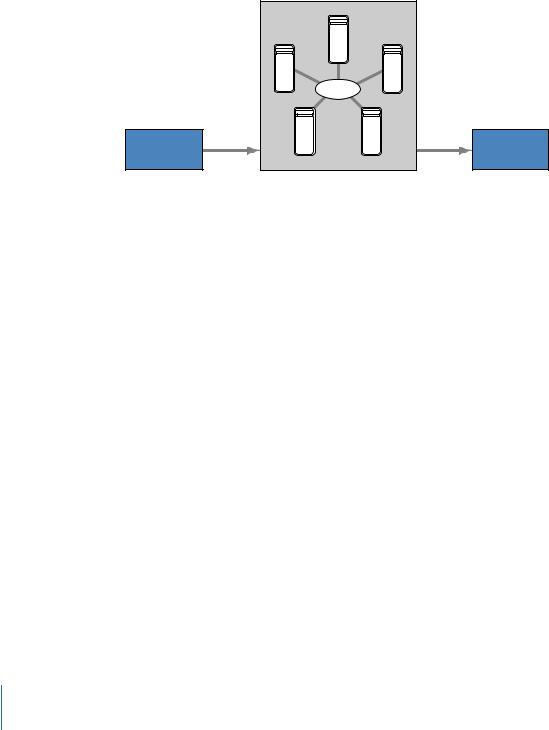
Computers that submit batches to the Apple Qmaster distributed processing system are called clients. A job is a processing task such as a Compressor preset-source pair, or a Shake file, or other files or commands that use UNIX commands to specify settings such as rendering instructions and file locations and destinations.
Batch of processing jobs
Network
Processed
files
Client computer |
Apple Qmaster cluster |
Destination folder |
Jobs are submitted. |
Processing is |
Files are placed at |
|
performed by cluster. |
specified destination. |
A batch is one or more jobs submitted for processing at one time. The procedure is analogous to printing multipage documents from a word processing program; the files are spooled and processed in the background. Although a batch can include just one job, you will typically want to submit several jobs at once for processing. Similarly, several people can use the same Apple Qmaster system at the same time, with several client computers sending batches in the same time frame. Batches are managed and distributed by the computer that is designated as the Apple Qmaster cluster controller, which is described in the next section.
Basic Components of the AppleQmaster Distributed Processing System
Although the Apple Qmaster software includes a few different applications (see The Interfaces), as a whole it is part of a networked system that includes the following basic components.
•Client(s): The computer or computers that use Compressor or AppleQmaster to submit jobs for distributed processing. Applications that can use Apple Qmaster services for processing include Compressor, Shake, Autodesk Maya, and many UNIX command-line programs.
•An Apple Qmaster cluster: An Apple Qmaster cluster contains:
•Servicenodes: The computers that perform the processing of batches submitted via Compressor or Apple Qmaster. A batch can include one or more jobs.
10 |
Chapter 1 Distributed Processing Basics |

•Cluster controller: The software, enabled on a computer by means of the
Apple Qmaster pane of System Preferences, that divides up batches, determines which service nodes to send work to, and generally tracks and directs the processes.
Client computer from
which users send jobs to the cluster
Cluster
(can contain multiple service nodes, but only one cluster controller)
Cluster controller manages the distribution of client’s jobs across the cluster
Service node |
|
Service node |
|
Service node |
|
Service node |
processes jobs |
|
processes jobs |
|
processes jobs |
|
processes jobs |
|
|
|
|
|
|
|
The client computer, the service nodes, and the cluster controller are often on separate (but network-connected) computers, for the most rapid processing potential. However, the cluster controller could be on a client computer or a service node. See Using One ComputertoServeTwoDistributedProcessingRoles formoreinformationonthisscenario.
Following is a closer look at the part each component plays in the Apple Qmaster system.
Clients
Batches are submitted for distributed processing from the client computers. A client computer can be any computer that has Compressor or Apple Qmaster installed and is on the same network (subnet) as the cluster controller. Multiple client computers can be on the same subnet, using the same cluster to do the processing for various applications.
You use Compressor or the AppleQmaster application to submit batches to be processed for a client. See the CompressorUserManualandthe AppleQmasterUserManualfordetails on using these applications.
Note: On any given Final Cut Studio system or network, the Compressor and
Apple Qmaster versions (numbers) and the version of QuickTime must all match. For example, Compressor 3.0.5 will work only with the 3.0.5 version of Apple Qmaster, and no other version. In this example, the correct version of QuickTime is QuickTime 7.5.5 or later. Non-matching configurations are not supported.
Chapter 1 Distributed Processing Basics |
11 |

Clusters
When a client sends batches to the Apple Qmaster distributed processing system, all the processing and subsequent moving of any output files is performed by a group of AppleQmaster–configured computers called a cluster. Youcancreateoneormoreclusters of service nodes, with one cluster controller included in each cluster. Each computer in the cluster is connected to the other computers in the cluster through a network connection.
Example of a cluster
Cluster |
Service |
Service |
Service |
controller |
node |
node |
node |
Note: This illustration provides only one simple example of a cluster. Other possibilities are described in Preparing a Network for Distributed Processing.
Service Nodes
The service nodes are where the processing work is done. When you assign a group of service nodes to a cluster, they function as one very powerful computer because all their resources are shared. If one service node is overloaded or otherwise inaccessible, another service node is used.
You make a computer available as a service node by configuring it in the Apple Qmaster pane of System Preferences. The simple steps involved in using System Preferences to configure a service node are described in Administering Clusters.
Note: The terms processing and rendering will come up frequently as you read this document. The term processing is used here in a general way to cover both rendering (for Shake and other frame-based rendering applications) and encoding (or transcoding or compression) for Compressor. For more information, see the Shake User Manual and the Compressor User Manual.
Cluster Controllers
The cluster controller software acts as the manager of a cluster. The cluster controller directs the distribution of batches within the cluster. It has the ability to determine the best use of the cluster resources based on work and availability variables. (See How the Apple Qmaster System Distributes Batches for more details.) The cluster controller is responsibleforacceptingbatchsubmissions,maintainingandmanagingthebatchqueue, and doling out the work to the appropriate service node. It also tracks the status of all outstanding batches.
12 |
Chapter 1 Distributed Processing Basics |

You make a computer available as a cluster controller by turning on the cluster–controlling service in the Apple Qmaster pane of System Preferences.
QuickClusters
The QuickCluster feature of the Apple Qmaster distributed processing system is a simple and automated alternative to creating and configuring clusters manually. For more information about QuickClusters, see Creating QuickClusters.
Compressor AutoClusters
The AutoCluster feature in Compressor gives you an easy way to take advantage of the distributed processing capabilities offered by Apple Qmaster without requiring a lot of knowledge about how clusters are configured, setting up file sharing, and so on. For more information about AutoClusters, see Using Compressor AutoClusters.
How the Apple Qmaster System Distributes Batches
The Apple Qmaster cluster controller determines the most efficient use of the cluster resources. It makes this determination based on the availability of each service node and the number of separable parts (described next) of the batch.
Because Apple Qmaster subdivides individual batches across different service nodes, the work is shared and completed more quickly. And, because this method uses all the service nodes as much as possible, you avoid under-utilizing your resources.
Batches can be distributed to a cluster by the cluster controller in one or both of the following ways. (Apple Qmaster determines which way is the most efficient for specific batches, depending on the circumstances.)
•The batch is subdivided into data segments: For example, for a render batch, the cluster controller could divide the frames into groups (segments). Each segment would be processed in parallel on the service nodes in the cluster.
•Thebatchissubdividedintotasks: For example, for a render batch, the cluster controller could subdivide the rendering work into different processing tasks. Different tasks would be run on different service nodes.
Chapter 1 Distributed Processing Basics |
13 |
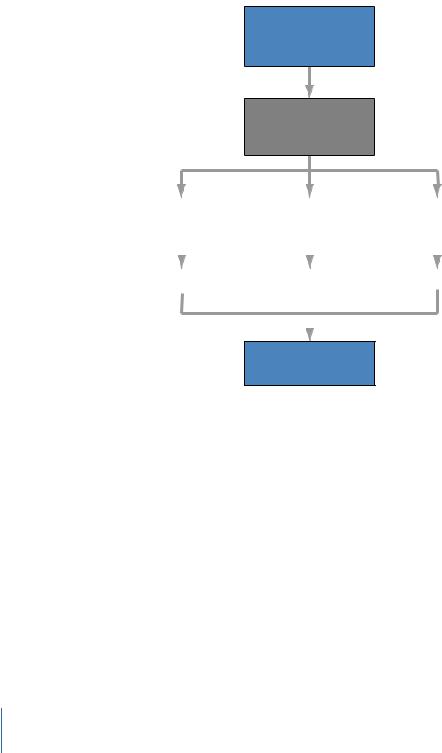
Rather than actually moving segments, Apple Qmaster tells the service nodes which segments to read via the network, where to find them, and what to do with them. Below is an example of how one batch could be processed in an Apple Qmaster system.
Batch submitted by Compressor or
Apple Qmaster (job request for frames 1–30)
Cluster controller divides and distributes job to available service nodes
Instructions specifying |
|
Instructions specifying |
|
Instructions specifying |
|||
locations of source files |
|
locations of source files |
|
locations of source files |
|||
and frames 01–10 |
|
and frames 11–20 |
|
and frames 21–30 |
|||
|
|
|
|
|
|
|
|
|
|
|
|
|
|
|
|
Service node 1 |
|
Service node 2 |
|
Service node 3 |
|||
|
|
|
|
|
|
|
|
|
|
|
|
|
|
|
|
Processed file (frames 1-30) placed in specified destination
In distributing batches, Apple Qmaster uses the technology built in to Mac OS X to locate services in a cluster on the same IP subnet and to dynamically share and receive information. Because the computers can continually transmit their current processing availability status, AppleQmaster can distribute (load-balance) the workload evenly across the cluster.
14 |
Chapter 1 Distributed Processing Basics |

Getting Started Quickly |
2 |
|
The Apple Qmaster distributed processing system has default settings that allow you to use distributed processing immediately.
This chapter covers the following:
•Quick and Easy Distributed Processing (p. 15)
•About the Compressor Service Sharing Pane (p. 19)
Quick and Easy Distributed Processing
The steps below describe the simplest and quickest way to start using distributed processing.
•Stage 1: Installing the Software
•Stage 2: Configuring a QuickCluster
•Stage 3: Adding Service Nodes to a Cluster
•Stage 4: Creating and Submitting a Batch
Stage 1: Installing the Software
Install the appropriate software on the computers you want to include in your distributed processing network. Each computer in the network requires Apple Qmaster and/or Compressor software.
To install the software
1Make sure the client software is on at least one computer in your network.
In order to submit jobs and batches to the distributed processing system, you need to use client (submission) software (either Compressor or Apple Qmaster). If you are reading this, you have probably already installed one or both of these. For further information, see the installation booklet that came with either of these applications.
2Install Apple Qmaster software on each computer you want to use for distributed processing. (All computers must be on the same subnet.) By default, the Final Cut Studio installer installs the Apple Qmaster software necessary for distributed processing.
15

However, in most standard distributed processing networks, you need to install
Apple Qmaster software on every computer in the network. You can use the standalone Apple Qmaster Node Installer to install the Apple Qmaster software on additional computers on your network.
aLocate the folder containing the Apple Qmaster software.
•If you are using Compressor: Insert the Final Cut Studio installation disc and locate the Apple Qmaster Node Installer package (AppleQmasterNode.mpkg).
•IfyouareusingShake: Insert the Shake installation disc and locate the AppleQmaster Node Installer package (AppleQmasterNode.mpkg).
bDo one of the following:
•Double-click the AppleQmasterNode.mpkg installer package, and follow the onscreen instructions. By default, this installer installs all the necessary AppleQmaster software.
•Install AppleQmaster software from the command line. See Installing AppleQmaster from the Command Line for more information.
Both the Final Cut Studio Installer and the Apple Qmaster Node Installer include the Compressor Service Sharing pane, in which you can quickly set up the computer as an unmanaged service node. See About the Compressor Service Sharing Pane for more information.
Note: On any given Final Cut Studio system or network, the Compressor and
Apple Qmaster versions (numbers) and the version of QuickTime must all match. For example, Compressor 3.0.5 will work only with the 3.0.5 version of Apple Qmaster, and no other version. In this example, the correct version of QuickTime is QuickTime 7.5.5 or later. Non-matching configurations are not supported.
Keep the following useful tips in mind as you prepare your Apple Qmaster distributed processing system:
•If you are using the Apple Qmaster distributed processing system with Compressor or Shake, all nodes (computers) in a cluster must have the same version of QuickTime installed. To download the most recent version of QuickTime, go to http://www.apple.com/quicktime/download/mac.html.
•In order to use the Apple Qmaster distributed processing system to process Dolby Digital Professional audio, each node (computer) in your distributed processing network must have Final Cut Studio installed.
•Shake users can create distributed processing clusters containing computers that do not have any Apple Qmaster software installed. See the Apple Qmaster User Manual for more information.
16 |
Chapter 2 Getting Started Quickly |
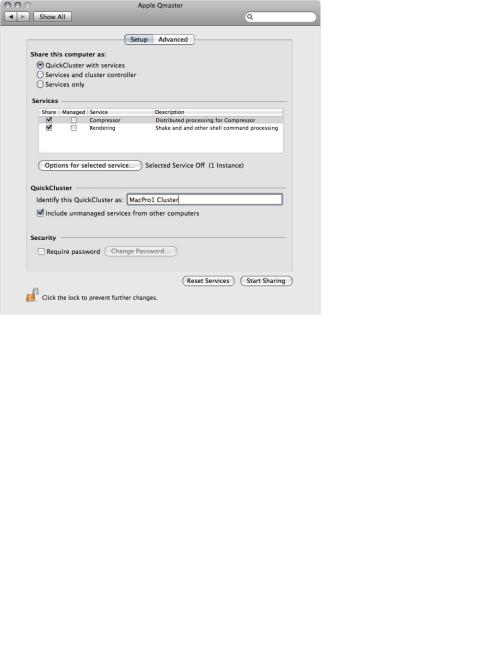
Stage 2: Configuring a QuickCluster
Use the Apple Qmaster pane of System Preferences to configure the cluster controller and service node computers.
To configure the cluster controller and service node computers 1 Open System Preferences.
2Click the Apple Qmaster button, located in the Other section. The Apple Qmaster pane appears.
3If the pane is locked, unlock it by clicking the padlock in the lower-left corner to enter the administrator name and password.
4Click Start Sharing.
This creates a QuickCluster with this computer as its controller, and an instance of processing services for each processor on the computer. For information about multiple serviceinstances,see UsingVirtualClusterstoMaketheMostofMultiprocessorComputers.
Stage 3: Adding Service Nodes to a Cluster
Do the following on each computer that you would like to make a service node on your cluster.
To add a service node to a cluster 1 Open System Preferences.
Chapter 2 Getting Started Quickly |
17 |
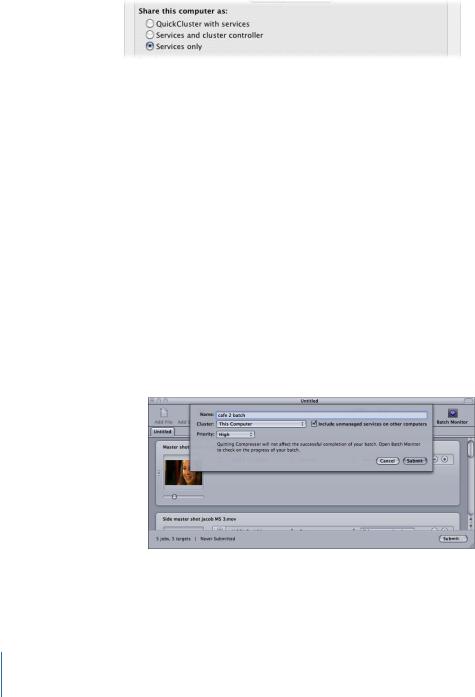
2Click the Apple Qmaster button, located in the Other section. The Apple Qmaster pane appears.
3If the pane is locked, unlock it by clicking the padlock in the lower-left corner to enter the administrator name and password.
4 Select “Services only.”
5Click Start Sharing.
This creates a service node that will automatically process jobs submitted to the QuickCluster you set up in Stage 2: Configuring a QuickCluster.
Stage 4: Creating and Submitting a Batch
In the Compressor Batch window or in the Apple Qmaster window, create a batch with one or more jobs. See the Compressor User Manual or the Apple Qmaster User Manual for details.
To submit the batch
1Do one of the following:
•If you are using Compressor: In the Compressor Batch window, click Submit, and in the resulting dialog, do one of the following:
•Use the Cluster pop-up menu to choose the cluster you created in stage 2.
•Leave the Cluster menu set to the default This Computer setting, and select the “Include unmanaged services on other computers” checkbox. For more information on this option, see Using Compressor AutoClusters.
18 |
Chapter 2 Getting Started Quickly |

•If you are using Apple Qmaster: In the Apple Qmaster window, choose the cluster you created in stage 2 from the Submit To pop-up menu.
2Click Submit.
The distributed processing system processes the batch.
For more advanced information on creating and controlling clusters and services, see any of the following:
•Basic Components of the Apple Qmaster Distributed Processing System
•Sample Setup for Part-Time Processing on Desktop Computers
•The Interfaces in the Apple Qmaster Distributed Processing System
•Apple Qmaster Pane of System Preferences
•Apple Qadministrator
•An Overview of Configuring a Cluster
•Configuring Service Nodes and Cluster Controllers
•Creating Clusters with Apple Qadministrator
•About QuickClusters
•Modifying and Deleting Clusters with Apple Qadministrator
About the Compressor Service Sharing Pane
Both the Final Cut Studio installer and the Apple Qmaster Node Installer include the Compressor Service Sharing pane, in which you can quickly set up the computer as an unmanaged service node. Selecting the Yes option in this pane is the first of two steps in setting up AutoClusters in Compressor. An AutoCluster is a temporary QuickCluster that you create automatically when you submit a batch. For more information about AutoClusters, see Using Compressor AutoClusters.
Note: You can change any of these settings at a later time in the Apple Qmaster pane of System Preferences.
If you are unsure which role each computer will play in your network, just install the Apple Qmaster software on each computer in your network. You can sort out the details later. See Basic Components of the Apple Qmaster Distributed Processing System for additional information on what roles individual computers can play in the distributed processing system.
Chapter 2 Getting Started Quickly |
19 |

Preparing a Network for |
3 |
Distributed Processing |
A distributed processing network can consist of as few as one or two computers, whereas a high-volume network may include many computers, an Xserve system and Xserve cluster nodes in a rack, and high-speed networking infrastructures.
You can scale up a distributed processing system as your workload demands by adding features and devices to the network that supports it.
This chapter covers the following:
•The Minimum You Need to Know (p. 21)
•Example of a Minimal Distributed Processing Network (p. 22)
•Using Compressor AutoClusters (p. 23)
•Other Possible Components of a Distributed Processing Network (p. 24)
•Example of an Expanded Distributed Processing Network (p. 26)
•Sample Setup for Part-Time Processing on Desktop Computers (p. 26)
•Configuring Access for Part-Time Distributed Processing (p. 27)
•Setting Up for Part-Time Distributed Processing with Shake (p. 29)
•Additional Steps for Distributed Processing with Shake (p. 30)
The Minimum You Need to Know
The following are the basic rules for setting up a distributed processing network:
•A cluster must contain one (and only one) computer acting as the cluster controller, and at least one computer acting as the service node. (These two can be the same computer, as shown in Example of a Minimal Distributed Processing Network.)
•The client computers and the computers in any cluster that supports them must be on the same network.
•The network must support the Apple networking technology built in to Mac OS X.
•All the computers in a cluster need read-and-write access to any computers (or storage devices) that will be specified as output destinations for files.
21

For information about a very basic setup, see Example of a Minimal Distributed Processing Network.
Example of a Minimal Distributed Processing Network
A very small distributed processing setup could include as few as two computers:
•One computer connected to the client and configured to act as both the service node and the cluster controller
•One client computer
Minimum setup for distributed processing
Client |
Service node with |
|
cluster controller enabled |
Though simple, this setup is useful in a small-scale environment because it allows the client computer to offload a lot of processing work.
See Example of an Expanded Distributed Processing Network for an illustration of a more powerful setup.
Using One Computer to Serve Two Distributed Processing Roles
To maximize your resources, you may want to consider using some computers for more than one distributed processing function.
•Servicenodeandclustercontroller: In a small setup, one of the service nodes in a cluster can also act as the cluster controller so that it performs both functions. However, in a cluster of many service nodes, the processing load required for the cluster controller could be so high that it would not be efficient to use one computer as both a service node and a cluster controller.
•Client computer and cluster controller or service node: You could also set up a client computer to act as a cluster controller or service node in a cluster, but again, keep in mind that the more available processing power a computer has, the faster it can manage or process jobs.
22 |
Chapter 3 Preparing a Network for Distributed Processing |
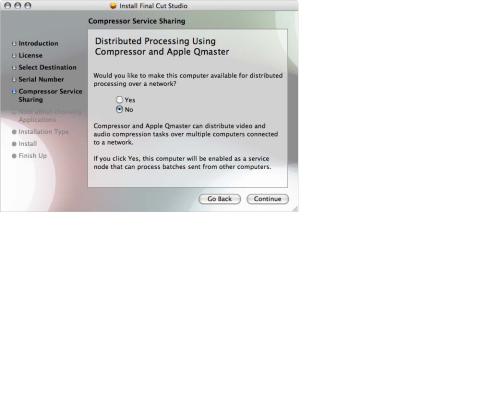
Using Compressor AutoClusters
The AutoCluster feature in Compressor gives you an easy way to take advantage of the distributed processing capabilities offered by Apple Qmaster without requiring a lot of knowledge about how clusters are configured, how to set up file sharing, and so on.
Using AutoCluster is a two-step process:
•Automatically creating Apple Qmaster service nodes as you install Final Cut Studio or Apple Qmaster
•Selecting “Include unmanaged services on other computers” when you submit a Compressor batch for processing
These two steps let you harness the processing power of any number of computers on your network without any additional effort or knowledge on your part.
•Stage 1: Creating Service Nodes During Installation
•Stage 2: Submitting Compressor Batches for Processing
Stage 1: Creating Service Nodes During Installation
Both the Final Cut Studio installer and the Apple Qmaster Node Installer include the Compressor Service Sharing pane, in which you can quickly set up the computer as an unmanaged Apple Qmaster service node, which is essentially a free agent “processing slave,” available on the network for any computer that requests its services.
If you select Yes in this pane, the AppleQmaster pane of System Preferences is configured as follows:
•Share this computer as: Services only
•Compressor service: Selected, unmanaged
•Start Sharing: Started
Chapter 3 Preparing a Network for Distributed Processing |
23 |

You can change any of these settings at a later time in the Apple Qmaster pane of System Preferences. For more information, see Apple Qmaster Pane of System Preferences and Administering Clusters.
Important: Although the Final Cut Studio installer requires a separate serial number for each computer, you can use the Apple Qmaster Node Installer (available in the Extras folder) to install the necessary Apple Qmaster software to make any computer on your network into an Apple Qmaster service node.
Stage 2: Submitting Compressor Batches for Processing
When you submit a Compressor batch for processing, a dialog appears that allows you to name the batch and select the computers to process the batch. At this point, you can harness the processing power of all the computers you set up as service nodes in stage 1 to complete the batch.
To process the batch using AutoCluster
1 Leave the Cluster pop-up menu set to the default selection (This Computer).
2Select the “Include unmanaged services on other computers” checkbox.
Compressor and Apple Qmaster coordinate the distribution of the processing tasks between the available computers and deposit the resulting output files at the location(s) you designated in Compressor.
OtherPossibleComponentsofaDistributedProcessingNetwork
There are many ways to expand the capacity of a distributed processing network. You could include any of the following.
•High-speed switch and cables: A 100Base-T or Gigabit Ethernet switch and compatible cables to allow your data to move over the LAN at maximum speed.
•Multipleclients: Multipleclientcomputerscanusetheservicesofthesamecluster. And, you can have multiple client applications on the same client computer, using the same cluster.
24 |
Chapter 3 Preparing a Network for Distributed Processing |

•Multiple clusters: Depending on how extensive your network is and how many clients it needs to serve, you may want to divide up available computers and create more than one cluster to serve various clients. (Users select the cluster they want to send a batch to when they submit the batch.)
•Multiple service nodes: In general, more service nodes mean more processing power. In deciding how many service nodes to have in a cluster, consider the ratio of data movement time to computing time. If the processing demand is greater than the network demand required to move job segments throughout the cluster, as is the case with rendering, more service nodes are a good idea. If the computing load, per job, is closer to the network load, having a smaller number of service nodes per cluster may be more efficient. If you are using the Apple Qmaster distributed processing system with applications other than Shake or Compressor, consult the application’s user manual on how to optimize the number of service nodes.
•Storage device: A storage device, such as a remote disk or group of disk arrays, can be used as cluster scratch storage, which is a place for short-term storage of temporary data generated by the cluster controller, clients, and service nodes. (You set the scratch storage location in the Apple Qmaster pane of System Preferences. See Using Cluster Storage.) Alternatively, a storage device can be used as a final destination for the files after they are processed.
For more information, see Example of an Expanded Distributed Processing Network.
Chapter 3 Preparing a Network for Distributed Processing |
25 |
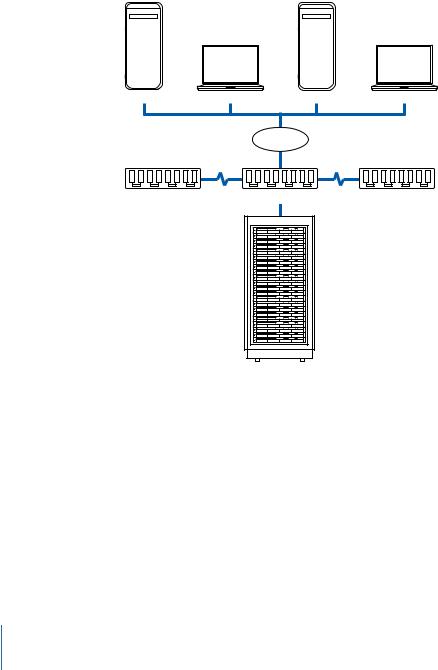
Example of an Expanded Distributed Processing Network
For rendering, a network might include a number of client computers on a LAN, connected to a cluster using a high-speed switch. A rack of servers plus a shared storage device, acting as the cluster, would be an extremely strong rendering engine. The service nodes would each have a local copy of the relevant client application software so that they could process the rendering jobs.
Example of a network setup for distributed rendering
Client |
Client |
Client |
Client |
LAN
High-speed switches (chained together)
Rack of servers containing cluster controller and service nodes,
plus rack-mounted shared storage device
Sample Setup for Part-Time Processing on Desktop Computers
This section takes you through the basic steps involved in a sample setup for “part-time” distributed processing. You can use it to get an idea of the kind of distributed processing environment you want to create, and as a guide in setting up that environment.
26 |
Chapter 3 Preparing a Network for Distributed Processing |
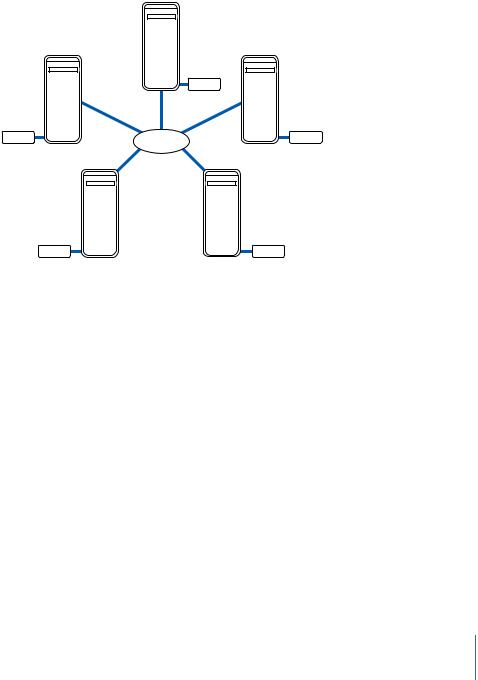
This setup is for an environment that uses desktop computers. It is called “part-time” processing because each computer acts as someone’s workstation, but at the same time is also part of the distributed processing cluster. The bulk of the processing jobs can be submitted with Compressor or AppleQmaster at the end of the day, so that the computers are busy processing a large queue of distributed processing batches after everyone has gone home. (See Scheduling Service Availability in the Work Schedule Dialog for information on scheduling service node availability.)
|
FireWire |
|
drive |
FireWire |
FireWire |
drive |
drive |
|
Network |
FireWire |
FireWire |
drive |
drive |
Each computer acts as both
a client that submits jobs for processing and a service node that performs the processing.
All source and output files are stored on the FireWire drives.
Inthesamplesetupshownabove,fivecomputersactasboththeclients(userworkstations from which users submit jobs for distributed processing) and cluster computers (which do the processing). Each computer has an additional volume, such as a FireWire drive, that is used for media before and after it is rendered, and for the associated files.
For more information on how to configure this desktop distributed processing environment, see Configuring Access for Part-Time Distributed Processing.
Configuring Access for Part-Time Distributed Processing
Follow the instructions below to set up a “part-time” distributed processing system.
Before you get started, keep these essentials in mind:
•The cluster computers (cluster controller and service nodes) and the client computers
(user workstations) need to be on the same local network (subnet).
Chapter 3 Preparing a Network for Distributed Processing |
27 |

•All the computers in the setup need read-and-write access to any volumes that will be specified as the source location or output destination for files, including Shake scripts. (An appropriate way to configure this access is included in the sample configuration procedure below.)
Stage 1: Installing Compressor and/or Apple Qmaster
The necessary components of Compressor or AppleQmaster need to be installed on each computer. See Stage 1: Installing the Software for more information.
On any given Final Cut Studio system or network, the Compressor and Apple Qmaster versions (numbers) and the version of QuickTime must all match. For example, Compressor 3.0.5 will work only with the 3.0.5 version of Apple Qmaster, and no other version. In this example, the correct version of QuickTime is QuickTime 7.5.5 or later. Non-matching configurations are not supported.
Important: The Compressor distributed processing feature for Dolby Digital Professional (AC-3) and Final Cut Pro is limited to computers that have Final Cut Studio installed.
Stage 2: Setting Up Media Storage
Make sure each computer has the necessary available storage, preferably a dedicated media volume. For example, give each computer a second volume, such as a FireWire drive, that is used for media. Each computer can use this volume for all source and destination files associated with distributed processing.
If you are a Compressor user, you can skip to one of the following chapters to complete the setup of your part-time distributed processing system:
•Getting Started Quickly
•Administering Clusters
If you are a Shake user and you cannot consolidate all of the necessary source files (Shake scripts, media files, and so on) on a single-cluster storage volume, skip to Additional Steps for Distributed Processing with Shake before going on to stage 3.
Stage 3: Creating a Cluster
First, use the Apple Qmaster pane of System Preferences to enable cluster controlling on one of the computers and enable the processing services on all the computers (making them service nodes). Then, you can assemble these computers as a cluster.
Apple Qadministrator may not be necessary. See Administering Clusters for detailed instructions.
28 |
Chapter 3 Preparing a Network for Distributed Processing |

Setting Up for Part-Time Distributed Processing with Shake
If you cannot consolidate all of the necessary source files (Shake scripts, media files, and so on) on a single-cluster storage volume, follow the instructions below.
•Stage 1: Turning Off the Shake UNC Setting
•Stage 2: Turning On Personal File Sharing
•Stage 3: Mounting the Media Storage Volumes
Stage 1: Turning Off the Shake UNC Setting
To make sharing and volume mounting work smoothly in this setup, you need to turn off the Shake UNC setting on each computer. The UNC setting uses the entire file pathname, with the network address, in a convention that starts with //ComputerName/DriveName/path.You don’t want Shake to use this filenaming convention because it conflicts with the file sharing and volume mounting used in this setup.
Note: All the media volumes created in stage 2 of Configuring Access for Part-Time Distributed Processing should have the same name.
In the three steps below, you make this change in a Shake startup .h file. As described in the Shake documentation, the startup .h files, located in the startup directory, are used to customize Shake settings (similar to setting preferences).
To turn off the UNC setting, do the following on each of the computers 1 Log in as the user who will use Shake on the computer.
2 Double-click the Terminal icon in /Applications/Utilities/ to open a Terminal window.
3Enter these two command lines in the Terminal window, pressing Return after each command line:
mkdir -p ~/nreal/include/startup/
echo 'script.uncFileNames = 0;' > ~/nreal/include/startup/UNC_off.h
Stage 2: Turning On Personal File Sharing
On each computer, turn on Personal File Sharing. This allows the computers to share the media volumes.
To turn on Personal File Sharing 1 Open System Preferences.
2 Click Sharing.
3 Select the File Sharing checkbox.
Stage 3: Mounting the Media Storage Volumes
Follow the instructions below so that all the computers in the cluster are mounting all the media volumes in the cluster.
Chapter 3 Preparing a Network for Distributed Processing |
29 |
